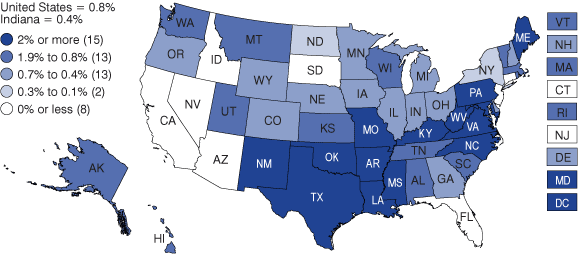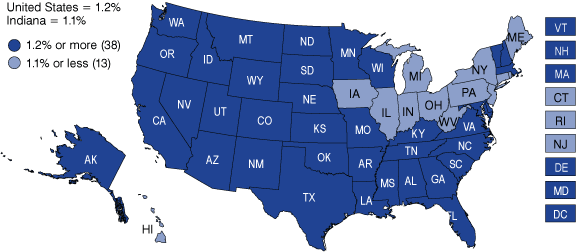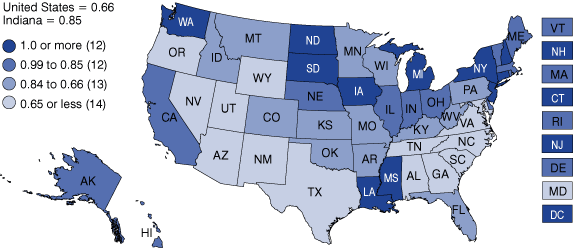Stability and Volatility in Personal Income Growth
Personal income in the nation grew by 0.8 percent from the first quarter of 2008 (2008.1) through the same quarter this year (2009.1); Indiana grew half as fast at 0.4 percent. We ranked 35th among the 50 states while West Virginia led the nation with a 4.5 percent growth rate and Nevada trailed with a 2 percent decline in personal income. In all, eight states saw nominal personal income fall (see Figure 1). Is it any wonder that so many states are in financial difficulties?
Figure 1: Percent Change in Nominal Personal Income, 2008.1 to 2009.1

Source: IBRC, using data from the Bureau of Economic Analysis
Over the longer 20-year period, 1990.1 to 2009.1, the nation's average rate of growth in personal income was 1.2 percent. The growth leader was Louisiana (3.0 percent), but that is misleading since hurricanes distorted the data with major collapses in personal income followed by dramatic increases. Second was Nevada at 1.9 percent, with Ohio and Michigan trailing at 0.9 percent; Indiana ranked 42nd at 1.1 percent (see Figure 2). The small spread in these averages suggests great economic equality of experience among the states over time. That is wrong.
Figure 2: Percent Change in Nominal Personal Income, 1990.1 to 2009.1

Source: IBRC, using data from the Bureau of Economic Analysis
Measuring Volatility
One way of looking at the disparity in experience is to consider the volatility or stability in growth by calculating the coefficient of variation (CV) for these states. The CV is the standard deviation of the growth rates divided by the mean of those rates for each state. Simply put, the CV measures stability or consistency over time. For example, if the growth rate is the same each quarter, the standard deviation would be zero and the CV would also be zero. But if the growth rates vary wildly, the standard deviation will be very high and the CV likewise will be very high. The higher the CV, the more variability (or volatility) in the growth rates; the lower the CV, the more stability in the growth of the state's personal income.
The national CV from 1990.1 to 2009.1 was 0.66; the standard deviation was two-thirds of the average growth rate. Louisiana, as expected, had the greatest volatility at 8.22 followed by North Dakota at 1.75. The most stable (or least volatile) were Maryland, South Carolina, and Tennessee at 0.56. Indiana ranked near the middle of the pack at 29th, close to Vermont and Maine, at 0.85 (see Figure 3).
Figure 3: Volatility in Growth of Personal Income, 1990.1 to 2009.1

Source: IBRC, using data from the Bureau of Economic Analysis
Rankings
Who got the prize for fastest growth combined with the least volatility? It was a close race that is hard to call. Should fast growth be given greater weight than stability of growth? What metric should be used to score the states in the contest? Here we take the easy way out and add together the rankings for each factor (growth and stability) to get an imperfect ranking of the states.
Nevada led by a nose, ranking second in growth rate and seventh in stability for a combined score of nine, the lowest in the nation. That barely beat out Utah, which was fourth in growth and sixth in stability. Next, and very close were Texas and Arizona. Trailing the field was Michigan, 49th in rate of growth and 43rd in stability. The slowest growing state, Ohio (50th), was more stable in 35th place, which bumped its combined rank to 47. Indiana's growth rank and stability combined for a rank of 36th (ranking 42nd in growth and 29th in stability), tying with Pennsylvania, which was 47th in growth and 27th in stability.
These results are surprising. Hoosiers have long believed that ours is one of the most volatile economies in the nation. These data suggest we reconsider that long-held belief. While manufacturing and agriculture may contribute to our volatility, other sectors may protect Indiana from being among the least stable states. That analysis must wait for another time.
Morton J. Marcus
Independent Economist
